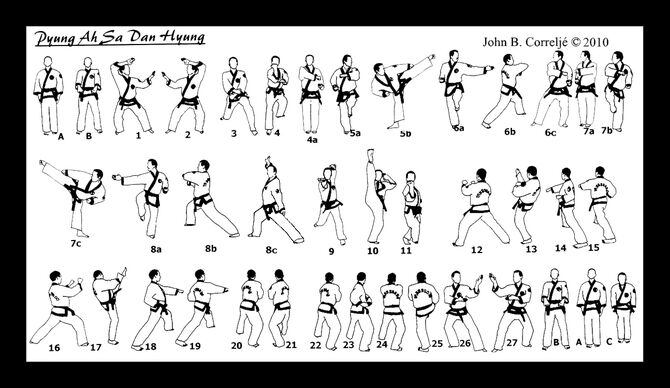This form is a traditional taekwondo form, meaning it pre-dates contemporary forms (such as those used by the ITF, ATA, and WT). In other words, this is a form used during the 1950s within the Nine Kwans that eventually came together to form taekwondo.
- Older forms such as this one were often based on forms from other martial arts.
- The details and names of these older forms tend to vary more widely from school to school as well.
The version shown here is just one version; the reader should recognize that there will be variations among schools.
The Pyung Ahn forms (also called Pyong An, Pinan, or Heian) originated in Okinawa. They were adapted by Anko Itosu from older Karate kata such as Kusanku and Channan into forms suitable for teaching karate to young students. When Gichin Funakoshi brought karate to Japan, he renamed the kata to Heian, which is translated as "peaceful and calm".
The Pinan kata were introduced into the school systems on Okinawa in the early 1900s, and were subsequently adopted by many teachers and schools. Thus, they are present today in the curriculum of martial arts styles such as Shitō-ryū, Wadō-ryū, Shōrin-ryū, Kobayashi-ryū, Kyokushin, Shinki-Ryu, Shōrei-ryū, Shotokan, Matsubayashi-ryū, Shukokai, Shindo Jinen Ryu, Kosho-ryū Kempo, and Kenyu Ryu. From Shotokan Karate they were adapted into use in Traditional Taekwondo.
One of the stories surrounding the history of the Pinan kata claims that Itosu learned a kata from a Chinese man living in Okinawa. This extremely long kata was called "Chiang Nan" by the Chinese man. The form became known as "Channan", an Okinawan/Japanese approximation of the Chinese pronunciation. The original long form of the Channan kata is lost. Itosu divided the form into 5 kataswhich he thought would be easier to learn. In taekwondo, these are:
- Pyung Ahn Cho-Dan
- Pyung Ahn Ee-Dan
- Pyung Ahn Sam-Dan
- Pyung Ahn Sa-Dan
- Pyung Ahn Oh-Dan
All of these forms use an I-shaped embusen.
Video
Diagram
This diagram is copyright John B. Correljé and is used with permission. Terms and conditions are available at http://sites.google.com/site/tangsoodochonkyong 
Written Instructions
- Joonbee
- 1. Left foot steps 90° counterclockwise into left Back Stance. Right Knifehand High Block simultaneous with left Knifehand Outward Block.
- 2. Turn clockwise 180° into right Back Stance. Left Knifehand High Block simultaneous with right Knifehand Outward Block.
- 3. Left foot steps 90° counterclockwise into left Front Stance. Low X-Block (right wrist over left).
- 4. Right foot steps forward into right Front Stance. Right Double-Arm Block.
- 5. Without stepping, simultaneously, left foot chambers (Crane Stance) and both fists chamber at right hip. Look left.
- 6. Left side kick simultaneous with left punch to left, landing into left Front Stance. Right Elbow Target Strike into left palm.
- 7. Right foot steps 180° clockwise into right Back Stance. Chamber both fists at left hip.
- 8. Left foot wedge steps to right foot. Simultaneously, right foot chambers (Crane Stance) and both fists chamber at left hip. Look right.
- 9. Right Side Kick simultaneous with right Punch to right, landing into right Front Stance. Left Elbow Target Strike into right palm.
- 10. Without stepping, left knifehand Low Block simultaneous with right Knifehand Outward Block. Twist 135° counterclockwise into left Elongated Front Stance. As the body turns the eyes stop at 90°, simultaneous with left Knifehand High Block and right Inward Knifehand Strike in the direction of the eyes.
- 11. From left Elongated Front Stance, right Front Kick with hands in same position, landing right foot forward. Left foot slides behind right foot simultaneous with right Backfist Strike and Kihap as left fist pulls to left hip.
- 12. Pivot 225° counterclockwise into left Front Stance. Grab the opponent's shirt. Right Front Kick, landing into right Front Stance. Right Middle Punch. Left reverse Middle Punch.
- 13. Right foot steps 90° clockwise into right Front Stance. Grab the opponent's shirt. Left Front Kick, landing into left Front Stance. Left Middle Punch. Right reverse Middle Punch.
- 14. Left foot steps 45° counterclockwise into left Front Stance. Left Double-Arm Block.
- 15. Right foot steps forward into right Front Stance. Right Double-Arm Block.
- 16. Left foot steps forward into left Front Stance. Left Double-Arm Block.
- 17. Without stepping, right and left arms extend forward and up (open hands). Pull down simultaneous with right Knee Strike and Kihap. Right foot lands 45° counterclockwise.
- 18. Pivot 180° counterclockwise into left Back Stance. Left Double Knifehand Block.
- 19. Right foot steps 90° clockwise into right Back Stance. Right Double Knifehand Block.
- 20. Turn 45° counterclockwise, pulling in the right foot.
- End.
